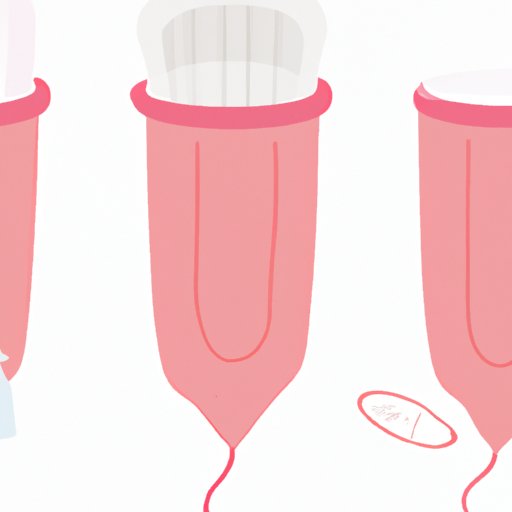
Introduction
Tampons are a convenient product for menstruating individuals. They allow for ease of movement and no visible panty lines. However, it is essential to understand the recommended wear time and potential risks associated with long-term use. In this article, we will explore how long you can have a tampon in, the do’s and don’ts of tampon usage, maximizing tampon efficiency, expert tips for staying safe and comfortable, the pros and cons of tampons versus menstrual cups, and the evolution of tampon usage across generations.
The Do’s and Don’ts of Tampon Usage: How Long is Too Long?
The recommended time frame for tampon usage is between four to eight hours. This can vary based on individual menstrual flow. Light flow may require less frequent changes, while heavy flow may require more frequent changes. It is essential to read the instructions provided by the tampon brand and change the tampon regularly to minimize the risk of bacterial infections such as Toxic Shock Syndrome (TSS). TSS is a rare but potentially fatal condition caused by bacterial toxins that can enter the bloodstream through a cut or abrasion and multiplied on the tampon, leading to fever, vomiting, and low blood pressure. A person may experience a rash that resembles sunburn, followed by eventual peeling of the skin.
Maximizing Tampon Efficiency: Understanding the Absorption Levels of Different Brands
It’s important to note that different tampon brands include different absorbency levels. It is crucial to match the absorbency level with your menstrual flow’s intensity. Using a tampon with a higher absorbency than necessary increases the risk of TSS. On the other hand, using a tampon that has a lower absorbency level than necessary may require changing frequently, causing discomfort. It’s essential to read the packaging, which indicates the tampon’s absorbency level to ensure maximum effectiveness.
The Unspoken Rules of Tampon Use: Expert Tips for Staying Safe and Comfortable
Inserting and removing a tampon may be challenging initially. Here are some expert tips to stay safe and comfortable while using tampons:
- Always wash hands before and after insertion and removal
- Change tampons regularly; 4-8 hours maximum.
- Do not insert a tampon without a menstrual flow
- Avoid over-insertion; position tampon so that the string hangs outside the vagina.
- Avoid using two tampons at the same time to increase absorbency
- See a doctor if experiencing itching, burning, or strange vaginal discharge
Menstrual Cup vs. Tampon: Which is Right for You?
A menstrual cup is another menstrual product that offers a new alternative to tampon use. A menstrual cup is a small reusable silicone cup that one can insert into the vagina, collecting menstrual flow over an 8-12 hour span. It has a lower risk of TSS and is an eco-friendly alternative. However, the effectiveness of a menstrual cup can vary based on menstrual flow and personal preference. Here are some pros and cons of tampons and menstrual cups:
Tampon Pros
- Widely available at drug stores, supermarkets.
- Easier to use for first-time menstrual product users.
- Convenient to carry and dispose of.
Tampon Cons
- Requires regular changing, which can be uncomfortable.
- Higher risk of TSS due to bacterial infection.
- May leave residue or fibers inside the vaginal wall which can cause discomfort or infections.
Menstrual Cup Pros
- Reusable and eco-friendly.
- Can be used for a more extended period – up to 12 hours.
- Lower risk of TSS.
Menstrual Cup Cons
- Can take some time to adjust to the correct insertion and removal techniques.
- The cleaning process required between uses may be inconvenient.
- Pricier than tampons or pads, but they are an investment and may save money over the long term.
Tampon Usage Across Generations: How Women’s Experiences Have Changed Over Time
The history of tampon usage may be traced back to ancient Egypt, utilizing papyrus as ancient tampons. Modern-day tampons were invented in the 1930s and marketed as a way for women to stay comfortable, active, and fit through their periods. In the past, tampons were marketed as a discreet product for physically active menstruating women. In contrast, today, it is a product viewed as accessible to all women regardless of activity levels or lifestyles. In recent years, tampon brands have also expanded their marketing to be more inclusive of all gender identities.
As technology and materials improve, tampons’ visibility in society continues to expand, making life more accessible for menstruating individuals. However, one thing remains the same: staying safe and comfortable while using this convenient product.
Conclusion
Understanding how to use tampons safely and efficiently is essential. A person should choose the right tampon absorbency that matches their menstrual flow to minimize the risk of bacterial infections such as TSS, change tampons regularly and maintain clean hygiene practices while handling and disposing of menstrual products. A person should also be aware of the alternatives to tampons, such as menstrual cups, to determine which product’s benefits suit their needs best. Always prioritize health and safety when using tampons or any menstrual product.




